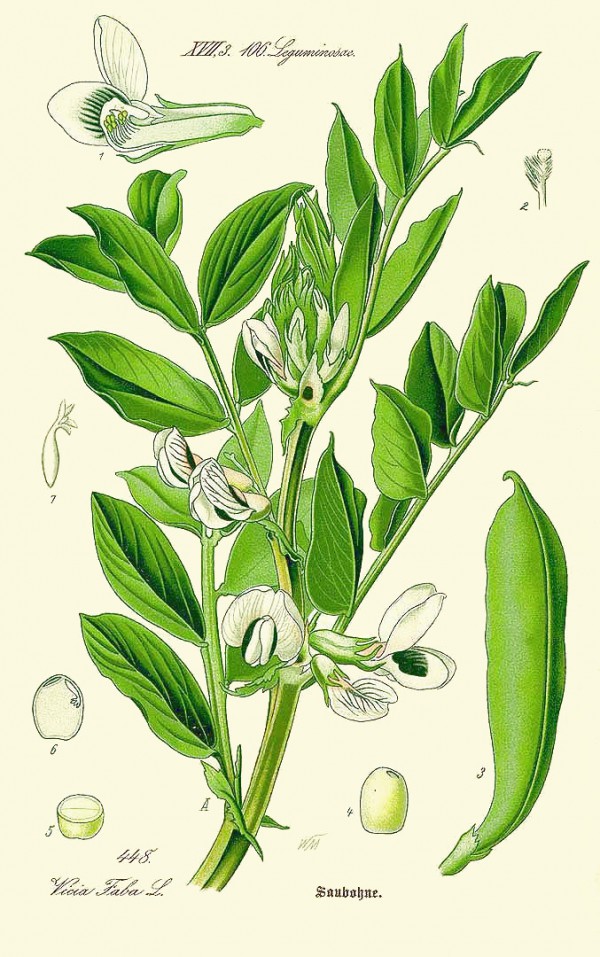Benutzer-Werkzeuge
Vicia faba L. - Fabaceae - broad bean, Ackerbohne, Saubohne
Erect annual plant, 60-150cm tall, probably native to S.W.Asia and N.Africa, widely cultivated for the edible seeds as food; leaves pinnate, 10-25cm, with 2-6 oval to elliptic leaflets 4-10cm long; flowers axillary 1-6, calyx 12-15mm long, corolla white to pink, standard petals white, wing petals white with a black spot; fruit pod, pubescent, 8-20cm long, 1-2cm broad, green, matures to brown; seeds 2-3cm, ovoid-oblong.
„The volatile compounds reported in V. faba consist mainly of aldehydes and alcohols, which represent over 60 % of the total composition in volatiles detected in the seeds (Oomah, Razafindrainibe, & Drover, 2014; Akkad et al., 2019). Alcohols and aldehydes are shown to be responsible for the green, grassy and beany notes associated with V. faba beans (MacLeod et al., 1988; Mishra, Tripathi, Gupta, & Variyar, 2017; Ong & Liu, 2018). Other compounds that potentially play a role in V. faba flavor on account of their low odor thresholds are 3-isopropyl-2-methoxypyrazine (0.004 ppb in water), a naturally-occurring methoxypyrazine associated with pea-like and earthy aromas (Murray & Whitfield, 1975; Czerny et al., 2008), 2-pentylfuran (6 ppb in water), a furan which can impart green, beany and earthy notes (Buttery, Seifert, Guadagni, & Ling, 1971; Sessa & Rackis, 1977; Oomah et al., 2014; Szczygiel, Harte, Strasburg, & Cho, 2017), and limonene (10 ppb in water), a terpenoid characterized by citrus, green and fruity odors (Buttery et al., 1971; Mishra et al., 2017; Akkad et al., 2019).“
[Sharan, Siddharth, et al. „Fava bean (Vicia faba L.) for food applications: From seed to ingredient processing and its effect on functional properties, antinutritional factors, flavor, and color.“ Comprehensive Reviews in Food Science and Food Safety 20.1 (2021): 401-428]
„In raw faba bean flour, 32 aroma-active compounds were quantified… 17 aroma compounds were selected for the aroma reconstitution of raw faba beans. Those were 3-methylbutanoic acid (OAV = 3005), methional (OAV = 132),
(E)-non-2-enal (OAV = 65), eugenol (OAV = 42), sotolon (OAV = 37), hexanal (OAV = 22), 4-vinylguaiacol (OAV = 10), benzaldehyde (OAV = 7.8), (2E,4E)-nona-2,4-dienal (OAV = 4.9), furaneol (OAV = 4.4), 2-phenylacetaldehyde (OAV = 4.0), (E)-oct-3-en-2-one (OAV = 2.7), oct-1-en-3-ol (OAV = 1.4), 2-methylbutan-1-ol (OAV = 1.0), 2-methylbutanal (OAV = 1.0), 3-methylbutan-1-ol (OAV = 1.0), and 3-methylbutanal (OAV = 0.5)… seven compounds … (E)-non-2-enal, sotolon, 2-methylbutan-1-ol, 3-methylbutanoic acid, hexanal, methional, and 3-methylbutanal returned p-values lower than 0.1. They should be considered as key compounds for the aroma impression of faba bean flour… Interestingly, no key aroma compound can be named which is connected to an “earthy”, “nutty”, or “beany” aroma impression. Therefore, those odor impressions might result from the interaction of two or more aroma compounds (Thomas-Danguin, Barba, Salles, & Guichard, 2017). Bott and Chambers (2007) evaluated the sensory impressions of mixtures of several aroma compounds and concentrations and found that combinations of hexanal, (E)-non-2-enal, 3-methylbutanal, (2E,4E)-nona-2,4-dienal, (2E,4E)-deca-2,4-dienal, and 1-octen-3-one can lead to a “beany” impressions.“
[Ritter, Stefan W., et al. „Identification of key aroma compounds of faba beans (Vicia faba) and their development during germination–a SENSOMICS approach.“ Food Chemistry 435 (2024): 137610]

Thomé, O.W., Flora von Deutschland, Österreich und der Schweiz (1886-1889) Fl. Deutschl. vol. 3 (1885) [tt. 317-461] t. 448
http://plantgenera.org/species.php?id_species=1060719
Vicia faba © Rolf Marschner (2007),
www.botanische-spaziergaenge.at
